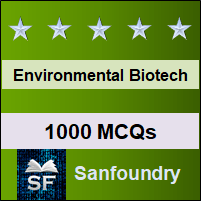
Environmental Biotechnology Multiple Choice Questions Highlights
- 1000+ Multiple Choice Questions & Answers (MCQs) in Environmental Biotechnology with a detailed explanation of every question.- These MCQs cover theoretical concepts, true-false(T/F) statements, fill-in-the-blanks and match the following style statements.
- These MCQs also cover numericals as well as diagram oriented MCQs.
- These MCQs are organized chapterwise and each Chapter is futher organized topicwise.
- Every MCQ set focuses on a specific topic of a given Chapter in Environmental Biotechnology Subject.
Who should Practice Environmental Biotechnology MCQs?
– Students who are preparing for college tests and exams such as mid-term tests and semester tests on Environmental Biotechnology.- Students who are preparing for Online/Offline Tests/Contests in Environmental Biotechnology.
– Students who wish to sharpen their knowledge of Environmental Biotechnology Subject.
- Anyone preparing for Aptitude test in Environmental Biotechnology.
- Anyone preparing for interviews (campus/off-campus interviews, walk-in interview and company interviews).
- Anyone preparing for entrance examinations and other competitive examinations.
- All - Experienced, Freshers and College / School Students.
Environmental Biotechnology Chapters
Here's the list of chapters on the "Environmental Biotechnology" subject covering 100+ topics. You can practice the MCQs chapter by chapter starting from the 1st chapter or you can jump to any chapter of your choice.- Issues and Scope of Environmental Biotechnology
- Management and Remediation of Problem Soil
- Bioaccumulation of Toxicants
- Biological Treatment of Waste Water
- Bacterial Metabolism in Wastewater Treatment Systems
- Wastewater Treatment of Food Processing Industries
- Biodegradation of Organic Pollutants
- Biotechnology for Solid Waste Management
- Biodegradation of Pesticides in the Environment
- Microbial Transformation of Heavy Metals
- Bioleaching and Biomining for Recovery of Resources
- Microbial Transformations of Pesticides
- Environmental Impact of Pollutants and Analysis of Dose – Effect Relationship
- Biotechnological Approaches of Microalgal Culture
1. Issues and Scope of Environmental Biotechnology
The section contains multiple choice questions and answers on environmental biotechnology basics, scope and issues.
|
|
|
2. Management and Remediation of Problem Soil
The section contains questions and answers on problem soil remediation management steps, intensive and extensive technologies, process integration, bioremediation suitability, in-situ and ex-situ techniques, biological treatment systems features, remediation techniques, coastal saline, alkali and mine waste soil management, soil pollution and other soil problems management.
3. Bioaccumulation of Toxicants
The section contains MCQs on xenobiotics characteristics, chemical structure and bioaccumulation relationship, bioaccumulation ecophysiology, toxicants process, bioaccumulation measurement and kinetic modelling.
4. Biological Treatment of Waste Water
The section contains multiple choice questions and answers on wastewater treatment microbial processes and microbial biofilm, secondary treatment systems, nitrogen removal through biomass production, microbial removal of nitrogen and phosphorous.
5. Bacterial Metabolism in Wastewater Treatment Systems
The section contains questions and answers on nitrogen removal during wastewater treatment, ammonia nitrification, enhanced biological phosphate removal, biological removal, biotransformation and biosorption of metal ions from contaminated wastewater.
6. Wastewater Treatment of Food Processing Industries
The section contains MCQs on slaughterhouses, dairy industry, fruit juice and beverage industries, breweries and distilleries.
|
|
|
7. Biodegradation of Organic Pollutants
The section contains multiple choice questions and answers on biodegradable organic pollutants, bacterial degradation principles, biopolymers aerobic bacterial degradation, fungi degradative capacities and organic pollutants degradation.
8. Biotechnology for Solid Waste Management
The section contains questions and answers on solid waste management basics, urban solid wastes composition, sanitary landfilling disposal, solid wastes aerobic treatment, biogas generation, aerobic and anaerobic solid waste treatment comparison, hazardous wastes treatment and biomedical waste management.
9. Biodegradation of Pesticides in the Environment
The section contains MCQs on pesticides types, pesticides fate in the environment, enzymes catalyzing pesticide degradation reactions, microorganisms and pesticide waste treatment.
10. Microbial Transformation of Heavy Metals
The section contains multiple choice questions and answers on microbes in metal containing habitat, metal-microbe interactions, heavy metal resistance genetic aspects and metal removal microbial applications.
|
|
|
11. Bioleaching and Biomining for Recovery of Resources
The section contains questions and answers on bioleaching process microbes and metal recovery, petroleum microbial extraction, fuels microbial production and phosphate microbial recovery.
|
|
|
12. Microbial Transformations of Pesticides
The section contains MCQs on pesticide metabolism fundamental reactions, beta – oxidation, oxidative dealkylation, thioether oxidation, decarboxylation, epoxidation, aromatic hydroxylation, hydrolysis, halogen reactions and nitro reductions.
13. Environmental Impact of Pollutants and Analysis of Dose – Effect Relationship
The section contains multiple choice questions and answers on toxicants doses, uptake, retention, dose-effect relationship and its applications, quantal and graded responses.
|
|
|
14. Biotechnological Approaches of Microalgal Culture
The section contains questions and answers on aquaculture microalgal species, mass cultivation techniques, algae commercial productions, closed and semiclosed outdoor culture systems, cells immobilisation, algal biomass harvesting and drying.
Wish you the best in your endeavor to learn and master Environmental Biotechnology!
